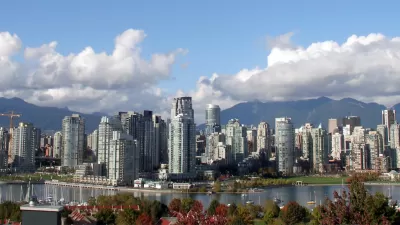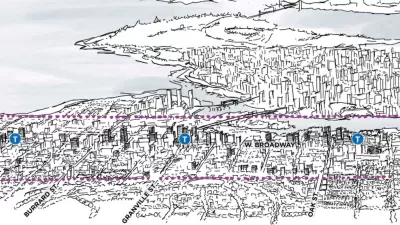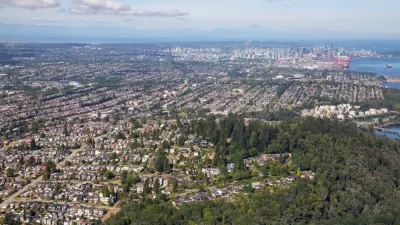In a significant step for more diverse housing and transit-friendly development, the Vancouver City Council eliminated parking minimums and adopted a Transit-Oriented Areas (TOA) policy.

In a significant step towards more diverse housing and fostering transit-friendly communities, today, Vancouver City Council adopted the Transit-Oriented Areas (TOA) Designation By-law and eliminated minimum parking mandates.
“This is a major milestone in our commitment to expanding housing choices for all Vancouver residents,” said Mayor Sim. “By integrating housing diversity with transit accessibility, we are paving the way for a more sustainable, inclusive, and vibrant city. These measures will help us meet the housing needs of our residents while fostering complete, connected communities.”
Today’s actions align with requirements under the Province’s TOA (Bill 47) legislation. Introduced in November 2023 this bill aims to promote the development of more diverse housing and the creation of walkable, transit-friendly neighbourhoods.
Transit-Oriented Area designation by-law
The City’s new TOA By-law designates 29 TOAs and adopts the following minimum densities:
- Rapid Transit (SkyTrain) Station: Within 200 metres, up to 20 storeys; within 400 metres, up to 12 storeys; within 800 metres, up to 8 storeys.
- Bus Exchange: Within 200 metres, up to 12 storeys; within 400 metres, up to 8 storeys.
The TOA By-law is accompanied with a rezoning policy which provides guidance on rezoning conditions, but is not itself a rezoning. Property owners will need to apply to rezone their property if they would like to increase height and/or density above what is currently allowed. The City is progressing through other work plans to proactively zone these and other areas, which will come forward to Council for future decisions.
Minimum parking requirements for all land uses eliminated city-wide
Council also voted today to eliminate minimum parking requirements, city-wide, for all land uses. This action goes beyond the Province’s legislation for Transit Oriented Areas TOAs and Small-Scale Multi-Unit Housing (SSMUH) and makes Vancouver the fourth Canadian city (after Edmonton, Toronto and Montreal) to remove these requirements.
Removing this requirement city-wide will advance the City’s objectives to simplify regulations and accelerate permit approval times as well as move us ahead on our transportation and climate emergency goals. Part of this work includes simplifying Vancouver's Parking By-law that will be reduced from 33 to 17 pages and 63 unique parking rates will be deleted. Accessible spots for people with disabilities, visitor spaces, bike parking spaces, and loading spaces will continue to be required.
Eliminating minimum parking requirements allows developers to provide the right amount of parking that their project needs. Staff do not anticipate significant impacts to on-street parking, however, tools such as time limits, pay parking or permit parking could be introduced to manage any impacts. (Read more in the Council report).
More diverse housing
City Council also passed amendments to the Zoning and Development By-law last week, aligning it with the Province’s SSMUH legislation (Bill 44). Multiplex homes are now permitted in more areas. This means the vast majority of Vancouver’s single family zones are now eligible for multiplexes.
Next steps
The City will ensure the effective implementation of TOA and SSMUH legislations. These changes, and other initiatives to advance more housing supply and housing options, are being advanced through the implementation of the Vancouver Plan. To mitigate land speculation and in alignment with achieving the objectives of the Housing Needs Report, the focus will continue to be on increasing rental and affordable housing over market condominiums.
FULL STORY: Vancouver passes two significant actions to promote diverse housing and transit-friendly communities

Alabama: Trump Terminates Settlements for Black Communities Harmed By Raw Sewage
Trump deemed the landmark civil rights agreement “illegal DEI and environmental justice policy.”

Study: Maui’s Plan to Convert Vacation Rentals to Long-Term Housing Could Cause Nearly $1 Billion Economic Loss
The plan would reduce visitor accommodation by 25% resulting in 1,900 jobs lost.

Why Should We Subsidize Public Transportation?
Many public transit agencies face financial stress due to rising costs, declining fare revenue, and declining subsidies. Transit advocates must provide a strong business case for increasing public transit funding.

Paris Bike Boom Leads to Steep Drop in Air Pollution
The French city’s air quality has improved dramatically in the past 20 years, coinciding with a growth in cycling.

Why Housing Costs More to Build in California Than in Texas
Hard costs like labor and materials combined with ‘soft’ costs such as permitting make building in the San Francisco Bay Area almost three times as costly as in Texas cities.

San Diego County Sees a Rise in Urban Coyotes
San Diego County experiences a rise in urban coyotes, as sightings become prevalent throughout its urban neighbourhoods and surrounding areas.
Urban Design for Planners 1: Software Tools
This six-course series explores essential urban design concepts using open source software and equips planners with the tools they need to participate fully in the urban design process.
Planning for Universal Design
Learn the tools for implementing Universal Design in planning regulations.
Smith Gee Studio
Alamo Area Metropolitan Planning Organization
City of Santa Clarita
Institute for Housing and Urban Development Studies (IHS)
City of Grandview
Harvard GSD Executive Education
Toledo-Lucas County Plan Commissions
Salt Lake City
NYU Wagner Graduate School of Public Service





























